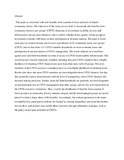| dc.description.abstract | This paper is concerned with who benefits from taxation of forest products in Nepal's community forests. The objectives of the study are two-fold; to document who benefits from community forestry user groups' (CFUG) financing of investments in public services and infrastructure and pro-poor initiatives and to explore whether biases against certain groups in investments coincide with biases in their participation in decision-making. The paper is based upon data on taxation income and revenue expenditures of 45 community-forest user groups (CFUG) and on data from 1111 CFUG member households on socio-economic status and participation in and perceptions of CFUG management. The results indicate an overall bias against poor and Dalit households in terms of access to CFUG funded public infrastructure. This overall picture conceals important variation; including that poor CFUG members have a higher likelihood of obtaining CFUG financed pro-poor loans than more well-off groups. However, members of the CFUG executive committees have an even higher likelihood of obtaining loans. Results also show that most CFUG members are knowledgeable about CFUG finances, but that they generally express dissatisfaction with the level of transparency about CFUG finances and decision-making processes. Further, poor and Dalit households are generally less knowledgeable on and participate less in CFUG management than other groups, and are less well represented on the CFUG executive committees. Thus, overall, the distribution of benefits from taxation of forest products in community forestry remains unequal, and the disadvantaged groups are poorly placed to claim a larger share of the benefits. Accordingly, the evidence presented in the paper exemplifies how participatory policies are framed by existing inequalities and social hierarchies, but also how such policies may modify these structures through affirmative strategies, such as the policy on pro-poor activities of CFUGs. | en_US |

